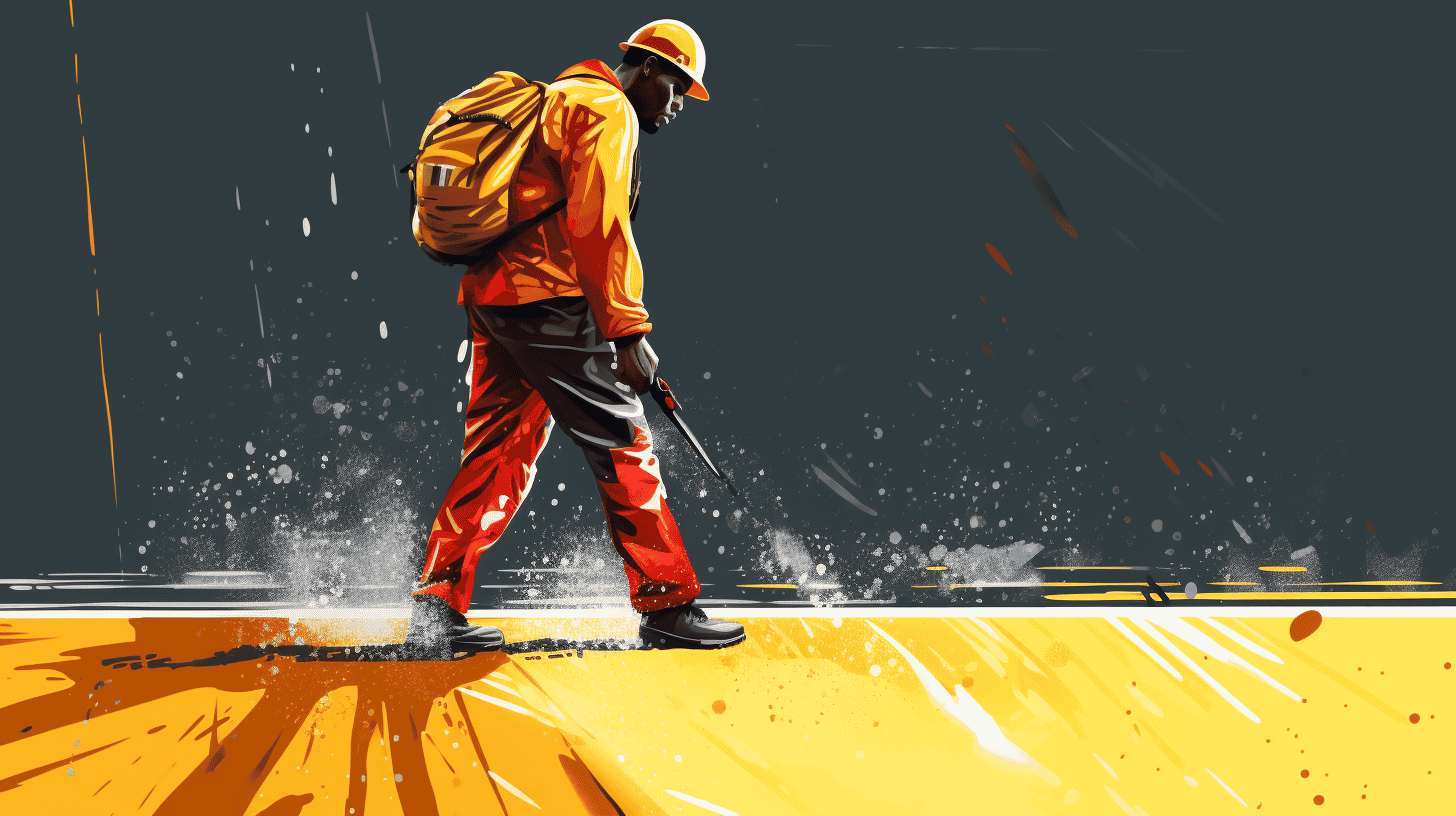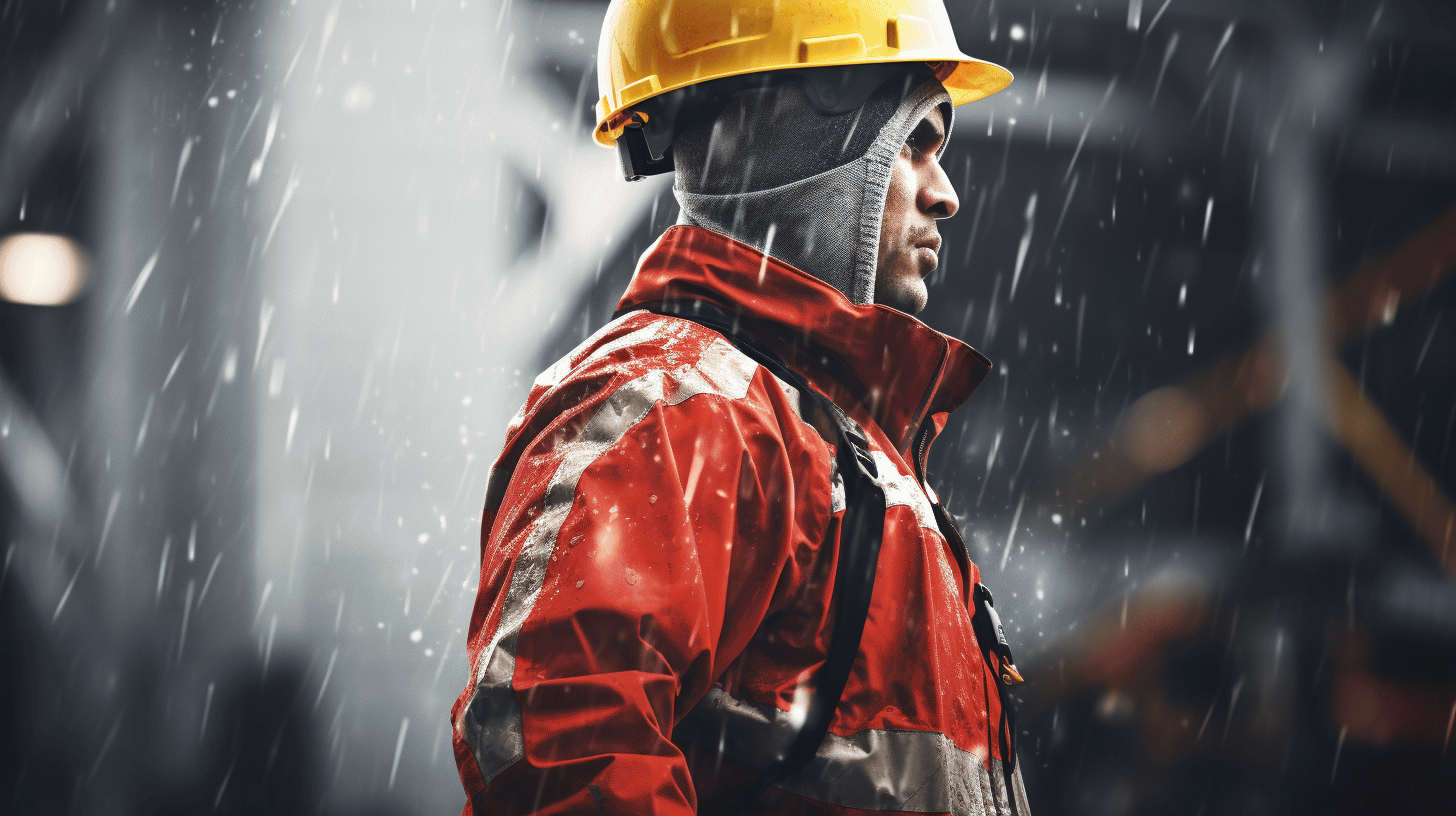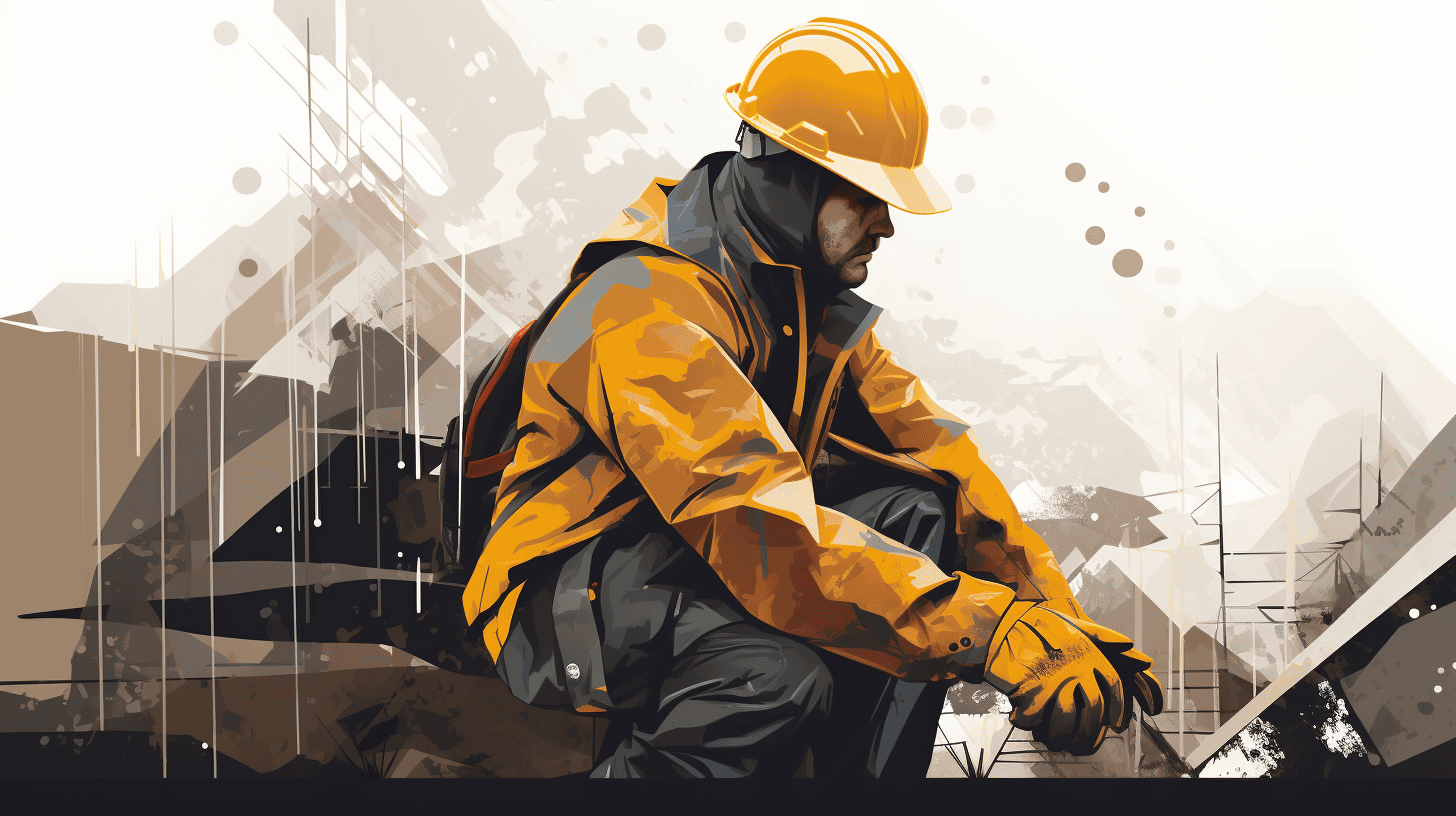Ever been stuck in the pouring rain on a construction site, all while wishing for a better way to keep dry? You're not alone. Construction work is tough, and the weather doesn't always cooperate. That sudden downpour can quickly turn your workday into a soggy mess. Yet, rain doesn't have to halt your productivity. Thanks to a solution known as rain gear, you can stay dry and warm, no matter the weather conditions. In this article, we will guide you through the fascinating world of rain gear designed specifically for construction workers. From the global rainwear market trends to the top materials used in making this vital protective gear, we've got you covered.
Global Rainwear Market
The growth of the global Rainwear market can best be described as a refreshing downpour. As we brace for the years coming, this sector is predicted to experience a robust surge, much like the monsoons. It's forecasted to grow at a Compound Annual Growth Rate (CAGR) of 5.5% from 2023. Yes, the landscape of the rainwear market is changing, and it's evolving fast!
Market Growth
We're currently witnessing a phenomenon, an awakening of sorts. People are increasingly acknowledging the significance of protective rain gear – be it for daily commute, athletic activities, or professional pursuits. From that trendy downpour-ready jacket to the integral rain boots, rainwear has evolved from being a seasonal essential to becoming a year-round wardrobe must-have.
Here are some factors fueling this growth:
- A thriving demographic of young people who have embraced the culture of fashionable, yet practical rain gear. They're looking for vibrant, trendy choices that don't compromise functionality.
- A budding segment of athletes, particularly those involved in outdoor sports. They've been influential in driving the demand for technologically advanced, weather-resistant apparel.
- A robust workforce consisting of constructors, bikers, and other professionals. They rely extensively on high-quality rainwear for their job efficiency and safety.
Considering these factors, the expanding rainwear market is hardly a surprise!
Market Drivers
One of the critical drivers propelling this booming market is the changing perception towards rain gear – it's no longer seen as just a protective necessity. Design innovation, technological advancements, and even eco-friendly alternatives have transformed the rainwear market, making it more diverse and vibrant than ever before.
We've also observed a significant increase in demand among construction workers. These professionals understand that when it comes to outdoor jobs, weather conditions can play a massive role in both productivity and safety. Hence, investing in the best rain gear becomes crucial for their line of work.
In a world where change is the only constant, the rainwear market keeps adapting. As the seasons shift and global conditions fluctuate, the demand for functional, durable, and stylish rain gear promises to drench the future in favorable prospects. Predicting market trends accurately isn't always possible, but the signs for the global rainwear market are as clear as a day with zero percent chances of rain – growth is on the horizon.
Top Rain Gear Materials for Construction
When you're in the construction industry, you can't let the weather dictate your work schedule. Rain or shine, there's a job to be done and deadlines to meet. For those wet and rainy days, it's crucial to have the right rain gear material that keeps you dry, comfortable, and safe on site. Let's dive right into the top rain gear materials used in construction.
Polyvinyl Chloride (PVC)
This hard-working material is at the top of the list for good reason. PVC, or polyvinyl chloride, is widely renowned for its waterproof properties. Constructed to combat the elements, PVC rain gear uniformly resists water infiltration, making it a practical option for those long hours under the rain.
Polyurethane (PU)
Next on the list is Polyurethane, or PU, a textile known for its versatility. PU is recognized for its high level of waterproofing, but its breathability sets it apart from PVC. This feature makes PU gear distinctively comfortable, keeping you dry without compromising freedom of movement - a vital characteristic for any construction worker.
Gore-Tex
There's a reason why Gore-Tex is a household name when it comes to outdoor equipment. This premium membrane offers superior waterproof ratings and breathability. For construction workers, Gore-Tex provides the ultimate protection without sacrificing comfort, making it well worth the higher price tag.
Sentinel
Sentinel material changes the game in terms of safety. Not only does it repel water effectively, but it also boasts reflective features for increased visibility on those dark, stormy days. Its performance surpasses comfort of other rain gear materials in the market, demonstrating that sometimes safety features don't need to compromise on comfort.
Polypropylene
Last but not least is Polypropylene. If breathability is your main concern, then look no further. Customer reviews for polypropylene rain gear rave about its high level of comfort thanks to its air-permeable nature. This incredibly light yet durable material makes hard work in bad weather a little more bearable.
Choosing the right rain gear material for construction shouldn't be a shot in the dark. Consider the job requirements and your personal comfort when making the decision. Whether it's PVC, PU, Gore-Tex, Sentinel, or Polypropylene, each of these materials have proven to be an excellent choice for those rainy work days.
Important Considerations for Choosing Rain Gear
In the venture to pick the perfect rain gear, it's vital to evaluate diverse aspects with a keen eye. From unrestricted visibility to unwavering waterproofing, each trait contributes to the overall performance and convenience of your outdoor wear. But, fear not! This comprehensive guide explores four fundamental characteristics of superior rain gear: visibility, waterproofing, breathability, and additional features, helping pick the best for you.
Visibility
Safety and functionality often take a front seat when venturing out in challenging weather conditions. As such, visibility becomes an essential factor when selecting your rain gear. Gear with reflective stripes or accents aids in lighting up your presence, even in dim, foggy, or stormy conditions. Plus, opting for rain gear in vibrant colors can significantly enhance daytime visibility.
Waterproofing
The crux of any rain gear, unsurprisingly, lies in its waterproof capabilities. Look for gear with high waterproof ratings to ensure you stay dry even in the heaviest of rainstorms. Notably, a lot of the best rain gear for construction work deftly couples robust waterproofing with sturdy material, effectively shielding you from the elements while enduring the demands of a hardcore worksite.
Breathability
As paradoxical as it may sound, the best waterproof gear should also breathe. Ever found yourself feeling soaked, not from rain, but from sweat trapped inside your impermeable jacket? That's where breathability comes into play. It ensures that sweat evaporates from inside the gear, keeping you comfortable and dry. However, remember that higher breathability might translate to a lighter fabric and potentially reduced waterproofing — a balancing act worth considering.
Additional Features
Lastly, pay attention to the smaller details — they can make or break your rain gear experience. Seeking features like adjustable hoods, reinforced seams, and convenient pockets can enhance the overall functionality of your gear. More importantly, consider the durability of the equipment and whether it meets the demands of your specific use.
So, whether you're gearing up for a drizzly hike or a downpour on the construction site, remember that the best rain gear marries practicality with comfort. By considering these four essential aspects, you'll be well-equipped to make an informed choice. Happy puddle-hopping!
Industrially Designed Rain Gear
When it comes to protecting yourself against relentless weather conditions during grueling outdoor tasks, nothing matches the reliability of industrially designed rain gear. From construction sites to outdoor expeditions, these garments ensure that rainfall neither compromises our safety nor dampens our work ethic. Today, we'll focus on two key pieces in this gear-line - jackets and pants - keeping you dry and comfortable as you brave the elements.
Jackets
Rain-soaked clothes are more than just an inconvenience; they could turn into a safety hazard for manual labor. This is where industrial-grade rain jackets step in. Their unique design factors guarantee an unmatched level of protection from the downpour.
- Material: Industrial rain jackets are often made from materials like PVC (Polyvinyl Chloride), which make them extremely durable and resistant to water.
- Seams: To prevent water seepage, these jackets usually have welded or taped seams.
- Visibility: For those working under low-light or foggy conditions, some jackets even include reflective stripes for better visibility.
Industrial rain jackets, however, do not just focus on practicality; they carefully consider user comfort. Components like adjustable cuffs, ventilated back yokes, and spacious cut designs ensure that users can carry on their activities conveniently, regardless of the rainfall.
Pants
As we move downwards, protecting the legs from getting drenched becomes equally crucial, especially for jobs that require a lot of movement. Like their jacket counterparts, industrially designed rain pants focus on optimizing user safety and comfort.
- Design: These pants usually feature high-waist designs to prevent water from seeping in. Often, they also include storm flap-covered pockets to keep your tools dry.
- Material: Industrial rain pants are made using materials like nylon and waterproof polyester, ensuring reliable rain protection without compromising flexibility.
- Adjustability: To fit all body types, these pants usually incorporate adjustable waistbands and snap adjustable leg openings.
To conclude with a thought, merely a roof over our heads isn't enough when it's pouring outside and our tasks demand us to step out. Embracing the robust build and thoughtful design of industrial rain gear, like jackets and pants, we indeed equip ourselves for heavy-duty applications in construction and other industries, ensuring our productivity continues to flow even when it's raining cats and dogs.
Safety-First Approach: High Visibility Rain Gear
When it comes to personal safety on a worksite, nothing beats a highly-visible, waterproof suit. The importance of high-visibility rain gear cannot be emphasized enough, especially for those brave individuals who tackle their work, rain or shine.
From construction workers maneuvering across complex sites to traffic policemen directing traffic on a pelting rainy day, high visibility rain gear has become a savior. Brightly colored and reflective, these garments stand out against any background, making the wearers highly visible even under low-light conditions.
Consider these facts:
- Visibility: High-visibility rain gear often features fluorescent colors and reflective tapes that significantly improve a worker's visibility to others, particularly when working in dim light conditions or adverse weather.
- Protection: Besides visibility, this rain gear also provides protection against harsh weather conditions. Whether it's heavy rain or high winds, wearing high-quality rain gear can keep workers dry, warm, and comfortable, enabling them to concentrate better on their jobs.
- Compliance: Lastly, many workplaces and industries have regulations that require workers to wear high-visibility clothing. Complying with these regulations can prevent costly fines and protect workers.
"High-visibility rain gear is essential for workers to ensure their safety."
When seeking to invest in high-visibility rain gear, it's crucial to factor in the quality of materials, reflective properties, waterproof ratings, and the gear's overall comfort. Remember, the main goal is to stay safe while ensuring that work goes on, regardless of the weather. Just as one wouldn't compromise on the quality of the safety helmet or gloves, similar attention should go into selecting suitable high-visibility rain gear.
In summary, high-visibility rain gear combines safety and practicality, enabling individuals to perform their jobs efficiently without compromising their security. So, whether you're a worker braving the elements or an employer committed to ensuring your team's safety, bear in mind that quality high-visibility rain gear is a game-changer. Take the safety-first approach by prioritizing high-visibility rain gear - because nothing is worth more than a human life. In the workplace, visibility equals safety.
Special Protective Gear
Part of the intrinsic nature of professional utility work is dealing with risky surroundings, and some of these risks may even include weather uncertainties and potential electric arcs. Due to these inherent hazards, it's absolutely crucial that utility workers are equipped with special protective gear, specifically designed to keep them safe from Mother Nature's whims and electrical threats. That's where NASCO comes in with its innovative product, the ArcWear line of rain gear.
NASCO's ArcWear
The ArcWear, a flagship product of NASCO, is worth mentioning in any discourse on special protective gear. Positioned at the forefront of personal protective equipment (PPE) for electric utility industry, the ArcWear line of rain gear is renowned for its unique dual protection nature.
Here are some reasons why the ArcWear stands out:
- Dual Protection: The ArcWear doesn't just protect against rain, it's also designed to guard workers against electric arcs. This dual functionality capability addresses the real, daily challenges encountered by utility workers. This is not just a raincoat; it's a utility worker's armor.
- Adherence to Safety Standards: Safety always tops the priority list for utility workers. To address this, the ArcWear conforms to all the essential safety regulations and even surpasses a few. The quality and effectiveness of the ArcWear's protection have been recognized in the utility industry.
- Comfort and Durability: Although protection is vital, a worker's comfort cannot be undermined. The ArcWear is designed to not only provide maximum protection but also ensure user comfort. Fairly lightweight and durable, it's designed to withstand extended usage in challenging conditions.
While the ArcWear is only one product in NASCO's line, there's no denying the value it brings to the utility industry. Every worker who steps out into uncertain weather or the proximity of electric arcs can trust the ArcWear to provide them with adequate protection.
Remember, remaining equipped isn't simply about having tools; it also entails having the appropriate protective gear to safeguard against any form of occupational hazard. So, let's credit where it's due: NASCO's ArcWear is certainly a game-changer in the realm of special protective gear for our dedicated utility workers.
Conclusion
The right rain gear can profoundly influence the functionality, comfort, and safety of construction workers in adverse weather conditions. Understanding the best materials, evaluating crucial features like visibility, waterproofing, and breathability, and selecting industry-specific designs can undeniably enhance the work productivity and safety of these hardworking individuals.
Rain Gear Pro, with its commitment to designing gear that excels in durability, comfort, and user-centric smart features, stands out as a tough contender in the industry. Highlighting the importance of high-visibility gear and offering special protective suits like our ArcWear, we constantly evolve with the guiding principle of maximizing comfort in the harshest weather conditions. Our waterproof and rip-resistant products, handcrafted in the Pacific North West, reflect our dedication to bringing you the best rain gear possible.
Remember, protection is only effective when the gear is actually worn. With Rain Gear Pro's high-quality, breathable, and user-friendly designs, workers are more likely to wear them consistently, enhancing their safety and comfort during their demanding tasks. Embrace the downpour, stay safe, and increase efficiency with the best rain gear in the market.
Frequently Asked Questions
-
What are the essential rain gear items for construction workers?
The essential rain gear items for construction workers include a waterproof jacket, rain pants, waterproof boots, waterproof gloves, and a waterproof hat.
-
Are there any specific features to look for when choosing rain gear for construction work?
When choosing rain gear for construction work, look for features such as waterproof and breathable materials, sturdy construction, reinforced seams, adjustable cuffs and hems, and reflective strips for visibility.
-
How do I maintain and prolong the lifespan of my rain gear?
To maintain and prolong the lifespan of your rain gear, always follow the manufacturer's care instructions, avoid using fabric softeners or bleach, hang the gear to dry after each use, and periodically apply waterproofing spray to restore the water repellency.
-
Can I wear my regular work boots in rainy conditions, or do I need special waterproof boots?
It is recommended to wear special waterproof boots in rainy conditions. Regular work boots may not be equipped to handle prolonged exposure to moisture and can become uncomfortable and potentially cause foot-related issues in wet conditions.
-
Is it necessary to wear rain gear in light showers, or is it mainly for heavy rain?
It is advisable to wear rain gear even in light showers as prolonged exposure to moisture can still make you uncomfortable, affect your productivity, and potentially lead to health issues. Preventive measures are always recommended.























Leave a comment
This site is protected by hCaptcha and the hCaptcha Privacy Policy and Terms of Service apply.